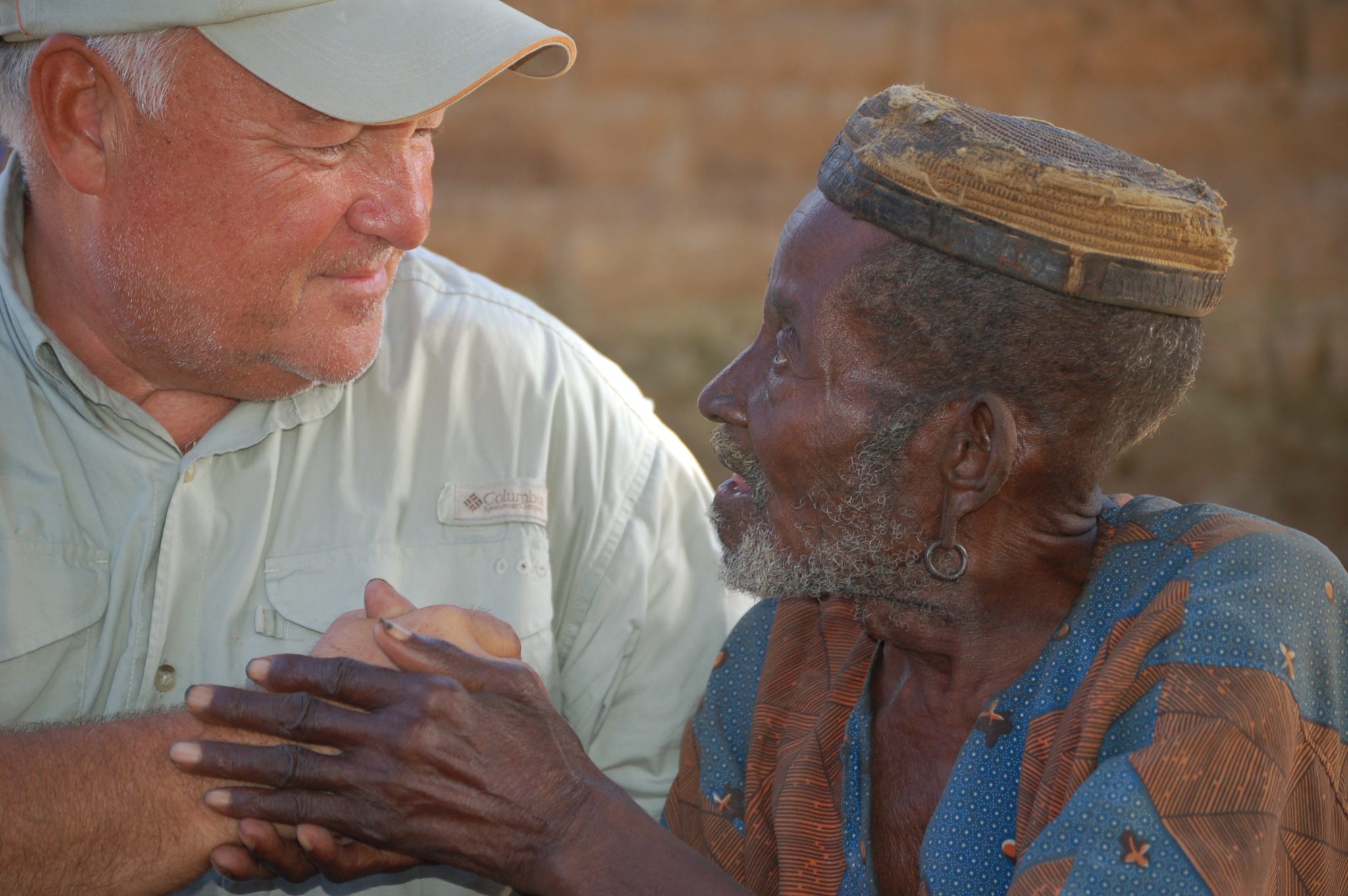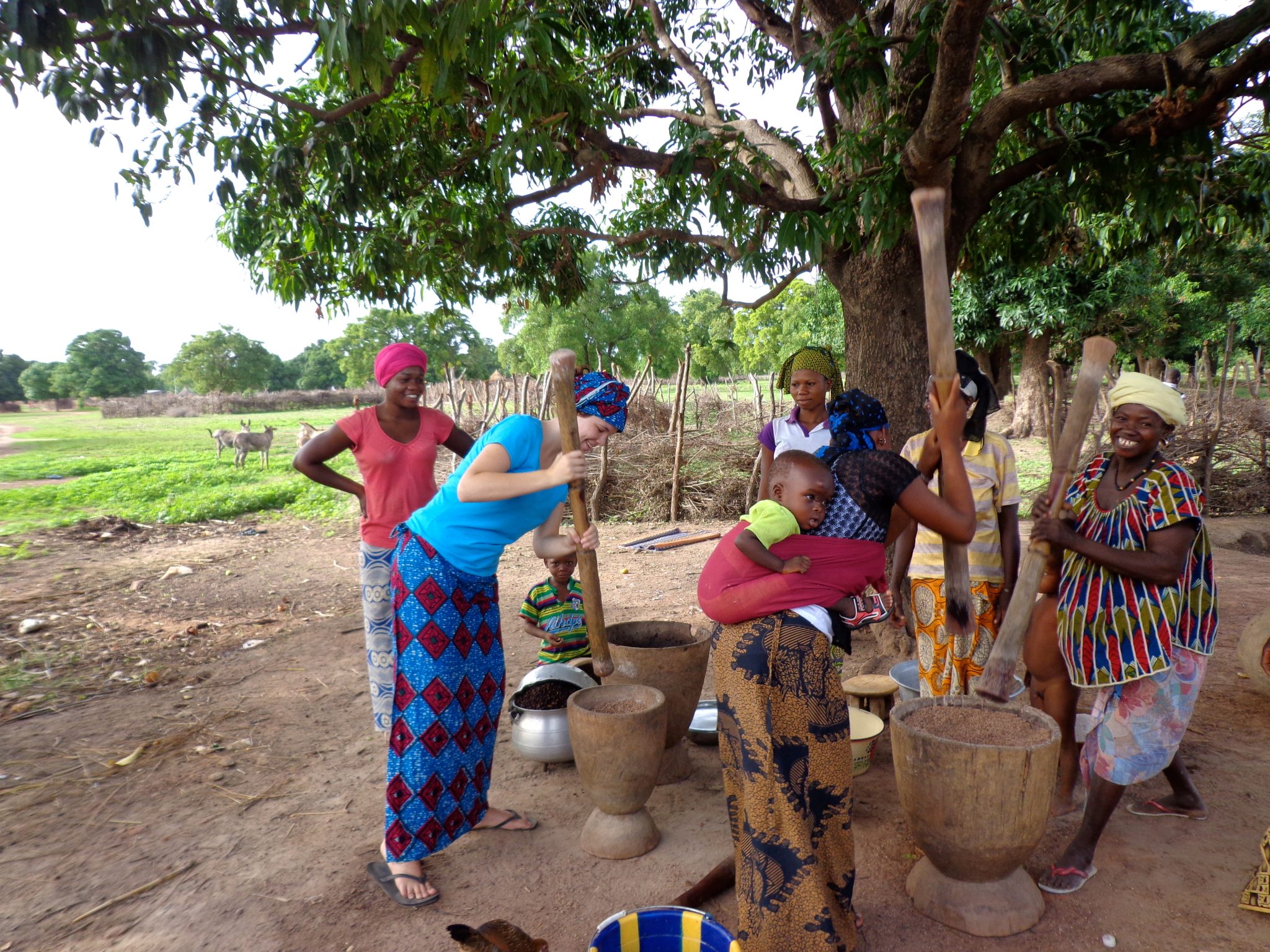At the Summit Church in North Carolina, the children’s facility is shaped like an airplane hangar.
The classrooms are marked like a terminal, with signs such as “Gate K1,” “Gate 24,” and “Summit Airlines” marking the way. Maps of the world hang prominently. And the sign over the exit says, “You are sent.”
It’s the refrain of the 10,000-attendee church—played on repeat.
When babies are born, parents are commissioned to raise them “as arrows to be launched out into the world,” Summit sending pastor Todd Unzicker said. By the time children finish middle school, the Summit wants them to have experienced a domestic, short-term mission trip with their family. By early high school, they’re encouraged to do a trip somewhere in the Americas; by senior year, around 25 of them—out of 250—will have committed to spend three weeks living with the Summit’s overseas missionaries.

The Summit asks every college student to give one summer to a mission trip. Then they ask for two years of mission work or church-planting participation after graduation.
They ask Baby Boomers for something similar, encouraging them to give the first two years of their retirement to be part of a church plant.
Every month, short- and long-term missionaries and church planters are publicly commissioned; when they return, they’re given a standing ovation.
When new believers are baptized, they’re asked if they believe Jesus saved them from sin and whether they’re willing to “do whatever he has called them to do and go wherever he has called them to go.” When communion is served, it’s sometimes presided over by missionaries on video, breaking bread in Africa or India or the Middle East.
Every one of pastor J. D. Greear’s sermons connects in some way to missions or church planting. (He has a standing Wednesday appointment with Unzicker to make sure that happens.) Instead of “you are dismissed” or “go in peace,” Summit pastors end each service with, “Summit, you are sent.”

“Peter Drucker famously said that culture eats strategy for breakfast,” Greear said. “At the Summit, we have built a culture of sending into everything we do.”
“Preaching that week in and week out over 10 years has had a big impact on the culture of the church,” church planting and leadership development pastor Mike McDaniel said.
This month, the Summit will celebrate sending out its 1,000th person in 15 years. The church has planted more than 40 churches in the United States and more than 200 overseas. For the first time in 2017, the average combined attendance of the plants (10,171) bested that of the Summit itself (9,973).
The church has planted more than 40 churches in the United States and more than 200 overseas. For the first time in 2017, the average combined attendance of the plants (10,171) bested that of the Summit itself (9,973).
Of the 46,000 churches in the Southern Baptist Convention, the Summit has the most missionaries on the field—seven-times as many as the next church with the International Mission Board.
“The growth is exponential,” said McDaniel, who also directs the Summit Network of churches in North America. “The number of those we are reaching through our church plants is growing far faster than our church has. We are seeing exponential impact. For every one person we have sent out, 20 new believers are worshiping in the kingdom of God.”
It hasn’t been painless. Creating a culture of sending can be exhausting. Money that could be used to make the congregation more comfortable is spent on salaries or rent for new plants. Constantly giving away some of the strongest leaders and donors can make the future feel uncertain or unstable.
But the steady, deliberate focus has paid off.
Getting Started
Fifty-seven years ago, pastor Sam James was hanging around Durham, North Carolina, waiting for his oldest son’s illness to clear up so he could head to the mission field. The former military man wasn’t good at sitting still—during his down time, he gathered a team and planted a church.
James had time to preach one message—from Isaiah 54, on lengthening the tent cords—before he got clearance from the International Mission Board (then the Foreign Mission Board) and took off for Vietnam.
His plant didn’t wither for lack of attention. Within four years, Homestead Heights Baptist Church grew to 150 members; within 20 years, it needed a new building to hold nearly 600 people. But by the 1990s, it plateaued and declined to about 300. When it called a young Greear in 2001, interim pastor Keith Eitel had been asking for prayer, fasting, and an emphasis on missions, and Homestead Heights was starting to perk up again.
Greear was young—just 28 years old—but not unknown to Homestead Heights. He had been called into ministry through a college Bible study, which he started for students who didn’t already go to Cru or InterVarsity. It ballooned to several hundred students, and Greear was hooked.
“I was like, ‘Man, this is what I want to do,’” he said.

He also felt God had called him to be a missionary. After seminary, Greear spent two years in Southeast Asia before heading back to Southeastern Baptist Theological Seminary in Wake Forest, North Carolina, for his doctorate.
Eitel hired Greear as a college pastor, but Greear’s church Bible study for college students wasn’t nearly as successful as his earlier one—at least numerically. His first Sunday, he was looking at just two young people—and one had already dropped out of school.
He worked at it for two years, growing the group to 25 students—decent in a church of 300 but not a lot considering Homestead Heights sat in the triangle between Duke University, the University of North Carolina, and North Carolina State University. There are 120,000 college students within 20 miles of the church.
Of the 46,000 churches in the Southern Baptist Convention, the Summit has the most missionaries on the field—seven-times as many as the next church.
Homestead Heights voted to call Greear as senior pastor in December 2001; he immediately relaunched it as The Summit Church (a play off Homestead Heights) and inspired the congregation to invite enough people to the Easter service to top 1,000 attendees.
“When God directed me to pastor this church, he never relinquished my call to the mission field,” Greear said. “He showed me I was supposed to reach the nations by mobilizing the American church.”
Mobilization comes a lot easier when the audience is young. So even if he didn’t know it yet, Greear needed more of those students in the pews.
Mobile Generation
“One week, five college students showed up,” Greear remembered. It was the fall of 2001. “They were friends of a friend of mine. They came in the same car, they sat together, and they must have really enjoyed the service.”
Apparently so—the next week, they brought their friends.
“It seemed like it went from 5 to 500,” he said. “And I think they all piled out of that same one car.”

It may have been, at least in part, the emphasis on mission. College students are looking for meaning and purpose; Greear was offering that in spades.
“‘Calling’ is not a special privilege for a sacred few of you,” he told them. “When you accepted the call to follow Jesus, you accepted the call to missions. The question is no longer if you are called; only where and how.”
It may also have been the concrete action steps the Summit offered. Over the next 17 years, leaders would build a pipeline that could take students from infancy to missionary—with options to jump in anywhere along the way.
‘Calling’ is not a special privilege for a sacred few of you. When you accepted the call to follow Jesus, you accepted the call to missions. The question is no longer if you are called; only where and how.
“After junior year, I went to Belgrade, Serbia, with the Summit for two months,” said Justin Leitch, who came to Christ at a Summit Bible study his sophomore year at North Carolina State. “That was really impactful for me. God gave me more of a vision of my path going a different direction than the work force. Leaders gave me affirmation about my evangelism and leadership gifting.”
The summer after he graduated with a mechanical engineering degree, Leitch lived with a church family while painting houses and raising money to come on staff at the Summit. In the fall he started full-time, doing college ministry at his alma mater.
At the same time, he interned with ministry training pastor Josh Miller. Leitch wrote prayer updates on church plants, attended church-planting conferences, and visited some of the Summit’s plants with Miller.

“A lot of little stuff kept fueling the vision [of planting],” Leitch said.
None of it was accidental; he was moving along the pipeline. Summit leadership had scouted Leitch’s potential, vetted him through different opportunities, and suggested next steps.
By the time Miller asked Leitch if he and his wife would consider moving to Charlottesville, Virginia, to be leaders in Miller’s church plant, “it wasn’t incredibly surprising.”
More importantly, being part of a church plant didn’t seem strange or scary. “We had seen it,” Leitch said. “We had friends that did it. We had friends move overseas to do it. We had raised support before. It felt normal in some senses.”
The Summit spends 17 percent of its budget on missions, including three years of financial support for each North American plant.
So far, Miller and Leitch have assembled 35 Summit members to go with them. That’s the best gift the Summit gives, Leitch said—even better than the money. (The Summit spends 17 percent of its budget on missions, including three years of financial support for each North American plant.)
Sending Bodies
In 2011, the Summit switched its missions model from simply writing checks to sending bodies along with those checks. It made a lot of sense in a church that was high on people but low on funds. (“I joke that when college students started coming to our church, our weekend attendance tripled and our weekly giving went down,” Greear said.)
For its first plant, a church in Denver, Colorado, the Summit sent not only a team, but a small congregation—25 people. Ever since, the Summit has been sending between 20 to 40 people at a time.
This is how the Summit sends out so many—they aren’t tapping hundreds of recent college graduates to pastor brand-new plants, but to plant in teams alongside lead pastors, most of whom have been to seminary and many of whom worked on staff at the Summit.

It helps that the younger generation is transitional—most aren’t looking to return to their hometowns, Greear said. About a third of those the Summit sends are college graduates.
“You’ve got to get a job somewhere,” Greear tells them. “Why not get a job in a place where God is doing something strategic? Following Jesus means doing what you do well for the glory of God, and doing it somewhere strategic for the mission of God.”
Another third are young professionals, and the final third are young families, McDaniel said. It’s a little harder to convince a family with older children to go; they tend to be rooted in neighborhoods and schools and activities, though they’re also more financially able to make the move, he said.
The most financially stable people are the Baby Boomers. They also have the most life experience.
“Forbes says the average retiree now lives 20 years after retirement,” Unzicker said. “We thought, What if we asked our Baby Boomers to tithe their retirement? What if they gave the firstfruits—the first two years—to be part of a church plant?”
The Baby Boomers haven’t been lining up to join in; like established families, Summit has sent just a few so far.
“We are just scratching the surface on this,” Unzicker said. “But as the church ages, this demographic—now 21 percent—is rapidly growing and is our best new mobilization group.”
Short-Term Mission Trips
“All of this sounds like everyone is on board,” Unzicker said. “We’re really excited to see over 200 churches planted and 250-something living abroad, but the reality is that 90 percent of our people are still not involved directly.”
The “needle mover,” the Summit found, is spending a week or two doing it.
“About 48 percent of our people doing local outreach ministry have been on a one-week international trip,” Unzicker said. “The people who tithe the most, who are involved in small groups, who are involved in their local community—it all came back to one thing. They’d been on a short-term trip.”
The same is true of those who move overseas. “They all say it started with a one-week trip to Honduras or Haiti,” he said. Those trips “are like discipleship microwaves. People can get out of their comfort zone and rely on the power of God, trusting in him in ways they don’t trust him every day, giving sacrificially in different contexts.”

Unzicker knows the downside of short-term trips. He spent two years as a missionary in Honduras, watching one-weekers come and go. When Helping Hurts is mandatory reading for Summit staff.
“You and I could talk about the bad side of short-term mission trips,” he said. “But far too often we throw the baby out with the bathwater. We go from one extreme to another.”
The Summit asks leaders on the field to direct the trip activity. Opportunities are provided for cross-cultural engagement. And the teams debrief at ethnic restaurants that bring back and solidify the lessons of the trip.
“If you go for a week and come back the same, it was a hypocritical week,” Unzicker said. But if the Summit can use that experience to get people to think about taking it further, it was worth it.
“We want to do it with excellence,” Unzicker said. “We want to balance deep and wide principles—deep in the gospel and casting a wide net. There’s something for everyone to be part of the mission of God.”
Counting the Cost
It’s expensive to plant churches, especially in the United States. The Summit spends more than $100,000 on each domestic plant, in addition to the cost of losing its strongest leaders, most involved volunteers, and most generous givers.
“People who sign up to go on church plants are not typically people sitting on the sidelines,” Greear said. The church motto is “We send our best.”
That means the Summit is always balancing, making sure the turnover doesn’t happen so often or fast that it harms the original flock.
It also means the church is constantly leaning on God to provide the next wave of leaders, volunteers, and givers.

“You can’t know or love God until you have an awareness of how big he is,” said Greear, who released Not God Enough: Why Your Small God Leads to Big Problems in February. “I’m a spiritual idolater and an American, which means I like a small ‘God’ that I can predict, explain, and control. But that’s not a God that can answer life’s mysteries, set your heart on fire, and give you a purpose you can live and die for.”
Greear’s purpose—and by extension the Summit’s—is equipping and deploying church planters.
“My parents told me they loved having kids, but when it really got fun was when their kids had kids,” said Greear, who is 44. “I think meeting people who came to faith through people we reached and sent out is like that. There is no greater joy than meeting spiritual great-grandchildren.”
The Summit is aiming for 1,000 church plants in 50 years.
“Based on the math right now,” Greear said, “it looks like we’ll be there long before 2050. By God’s grace, we’re just getting started.”
Is there enough evidence for us to believe the Gospels?
 In an age of faith deconstruction and skepticism about the Bible’s authority, it’s common to hear claims that the Gospels are unreliable propaganda. And if the Gospels are shown to be historically unreliable, the whole foundation of Christianity begins to crumble.
In an age of faith deconstruction and skepticism about the Bible’s authority, it’s common to hear claims that the Gospels are unreliable propaganda. And if the Gospels are shown to be historically unreliable, the whole foundation of Christianity begins to crumble.


































